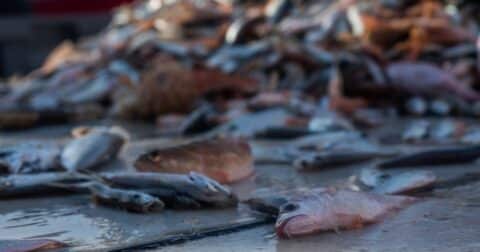News
Meat Consumption Grows in US and Asia, While Europe is on the Decline
Climate•3 min read
Solutions
Just by ending the practice of overfishing, we could store the same amount of carbon as 6.5 million acres of forest each year.


Words by Sophie Kevany
In the search for winning climate solutions, the world’s oceans are an undisputed powerhouse. Oceans absorb around 31 percent of our carbon dioxide emissions, and hold 60 times more carbon than the atmosphere. Critical to this valuable carbon cycle are the billions of sea creatures who live and die underwater — whales and anchovies alike. Yet our ever-growing global appetite for fish threatens the oceans’ climate power. So much so that researchers in Nature argue there is “a strong climate change case” for putting a stop to overfishing.
Even though there is fairly widespread agreement on the need to end this practice, there is virtually no legal authority to make it happen. Still, if the planet could figure out a way to stop overfishing, the climate benefits would be enormous: 5.6 million metric tons of CO2 per year. And bottom trawling, a practice akin to “rototilling” the sea floor, increases emissions from global fishing by over 200 percent, according to research from earlier this year. To store the same amount of carbon using forests would require 432 million acres.
Every hour, oceans take in around a million tons of CO2. The same process on land is far less efficient — taking a year and a million or so acres of forest.
Storing carbon in the ocean requires two major players: phytoplankton and marine animals. Like plants on land, phytoplankton, also known as microalgae, live in the seawater’s upper layers where they absorb sunlight and carbon dioxide, and release oxygen. When fish eat the microalgae, or eat other fish that have eaten it, they absorb the carbon.
By weight, each fish body is anywhere from 10 to 15 percent carbon, says Angela Martin, one of the co-authors of the Nature paper and a PhD student at the Centre for Coastal Research at Norway’s University of Agder. The bigger the dead animal, the more carbon it carries downward, making whales unusually good at taking carbon out of the atmosphere.
“Because they live for so long, whales build up huge carbon stores in their tissues. When they die and sink, that carbon is transported to the deep ocean. It’s the same for other long-lived fish like tuna, bill fish and marlin,” says Natalie Andersen, lead author of the Nature paper and researcher for the International Programme on the State of the Ocean.
Remove the fish and there goes the carbon. “The more fish we take out of the ocean, the less carbon sequestration we are going to have,” says Heidi Pearson, a marine biology professor at University of Alaska Southeast who studies marine animals, particularly whales, and carbon storage. “Plus, the fishing industry itself is emitting carbon.”
Pearson points to a 2010 study led by Andrew Pershing, which found that had the whaling industry not wiped out 2.5 million great whales during the 20th century, the ocean would have been able to store nearly 210,000 tons of carbon each year. If we were able to repopulate these whales, including humpbacks, minke and blue whales, Pershing and his coauthors say that would be “equivalent to 110,000 hectares of forest or an area the size of the Rocky Mountain National Park.”
A 2020 study in the journal Science found a similar phenomenon: 37.5 million tons of carbon were released into the atmosphere by tuna, swordfish and other large sea animals targeted for slaughter and consumption between 1950 and 2014. Sentient’s estimates using EPA data suggest it would take about 160 million acres of forest a year to absorb that amount of carbon.
Fish poop also plays a role in carbon sequestration. First, waste from some fish, like California anchovy and anchoveta, is sequestered faster than others because it sinks quicker, says Martin. Whales poop much closer to the surface, on the other hand. More correctly known as a fecal plume, this whale waste essentially acts as a microalgae fertilizer — which enables the phytoplankton to absorb even more carbon dioxide.
Whales, Pearson says, “come to the surface to breathe, but dive deep to eat. When they are at the surface, they are resting and digesting, and this is when they poop.” The plume they release “is full of nutrients that are really important for phytoplankton to grow. A whale’s fecal plume is more buoyant which means there is time for the phytoplankton to take up the nutrients.”
While it’s impossible to know the exact amount of carbon we could store by ending overfishing and bottom trawling, our very rough estimates suggest that just by ending overfishing for a year, we would allow the ocean to store 5.6 million metric tons of CO2 equivalent, or the same as 6.5 million acres of American forest would absorb in that same time period. The calculation is based on the carbon storage potential per fish from the ‘Let more big fish sink’ study’ and the annual global fish catch estimate of 77.4 million tons, of which about 21 percent is overfished.
More reliably, a separate study released earlier this year suggests banning bottom trawling would save an estimated 370 million tons of CO2 each year, an amount equivalent to what it would take 432 million acres of forest each year to absorb.
One major challenge, however, is that there isn’t universal agreement on ocean protection, let alone overfishing. Protecting ocean biodiversity, controlling overfishing and reducing marine plastic are all goals of the high seas treaty put forth by the United Nations. The long delayed treaty was finally signed in June last year, but it is yet to be ratified by 60 or more countries and remains unsigned by the U.S.
If sparing fish could store this much carbon out of the atmosphere, are fish really a low-emissions food? Researchers aren’t sure, says Martin, but groups like WKFishCarbon and the EU-funded OceanICU project are studying it.
A more immediate worry, says Andersen, is interest from the fishmeal sector in turning to deeper areas of the ocean to source fish for feed, from parts of the sea called the twilight zone or the mesopelagic region.
“Scientists believe the twilight zone contains the largest biomass of fish in the ocean,” says Andersen. “It would be a major concern if industrial fisheries started targeting these fish as a food source for farmed fish,” Andersen warns. “It could disrupt the ocean carbon cycle, a process that we still have so much to learn about.”